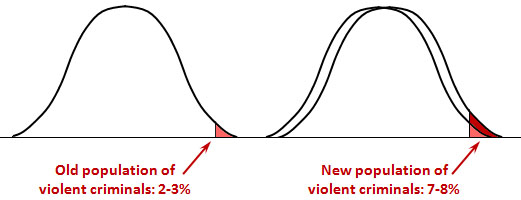Here’s something I want to toss out, even though I don’t have an answer to offer—or even a clue, really. It’s about lead.
People periodically ask me about whether lead might be responsible for some phenomenon or other. I’m generally very careful about this stuff. It’s possible that lead poisoning is responsible for lots of things, but in most cases the effect is likely to be (a) fairly small and (b) swamped by other factors anyway. That makes it all but impossible to measure, and if you can’t measure it you can’t really say anything about it.
The things that are easiest to measure are behaviors at the far end of the bell curve. Here’s why: if lead affects some behavior by a little bit, it will push the mean of the bell curve over by a point or two. Most of the time, this is just too small to measure. But the tail of the bell curve might be doubled or tripled in size. This is the case with violent crime, for example, which is why it’s feasible to correlate lead and crime.

What other behaviors are fairly rare, and therefore might increase by a large amount due to lead poisoning? For some reason, it recently occurred to me to be intrigued by the Case-Deaton study of “deaths of despair.” There are some technical problems with their original paper, but I think everyone agrees that even when those are corrected there’s still something going on. And that something is primarily affecting people who are about 50 years old.
The peak years for lead poisoning in the US were 1965-1975. People born in those years are now ages 43-53. Is there some kind of connection?
The fact that this doesn’t seem to be happening in other countries—which is pretty much the whole point of the Case-Deaton paper—suggests that lead may not be the culprit. There’s also the fact that it seems to affect whites more than blacks, which is the opposite of what you’d expect if lead was involved. At the same time, it’s possible that lead has an effect that only shows up if other conditions help it along. Who knows?
In any case, it seems like this might be worth a look. I’m not entirely sure how to look at it, though. Take tooth samples of folks who drink themselves to death to check for lead concentrations? That’s not especially likely. But maybe there are less intrusive ways of establishing whether there’s a correlation in the first place. If there is, it would be worth further study.














